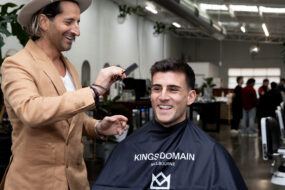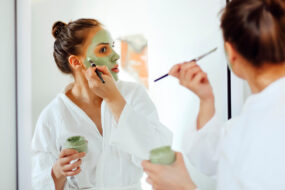Skincare for men in their 20s, 30s, 40s and beyond
You can’t stop the process of ageing, but a solid skincare routine can still have a profound impact on the health and condition of your skin.
Chasing the fountain of youth isn’t a new phenomenon, and these days it’s not just women feeling the pressure.
Rather than trying to turn back the clock, men are encouraged to dial up their grooming routines to include effective, efficient skincare, which can transform the condition of their skin in the process.
Bulking up your grooming kit and tweaking your daily regimen could be all it takes to help prevent premature ageing at every decade.
In your 20s
For most men, your 20s are when your skin looks its best.
Aside from underlying skin conditions, skin at this life stage is typically supple, youthful and generally fuss-free, requiring little maintenance to look good.
Hormonal acne has typically subsided, and collagen and elastin production remains strong.
This is where a preventative skincare routine reigns supreme.
Consider external factors linked to premature ageing, such as sun exposure and UV damage, and it’s a no-brainer why sun-smart tactics such as applying facial sunscreen daily should be integral to your routine.
O Cosmedics founder Maria Enna-Cocciolone, a long-time beauty and grooming expert, says in your 20s the goal is preservation.
“Your skin needs you to start taking care of it as early as possible by building healthy habits,” Maria says.
Besides moisturising and a daily application of good-quality SPF 50+ sunscreen, one of these habits is exfoliation.
Advanced Cosmeceuticals Skin Group head skincare educator Michelle Jay notes exfoliation is “crucial” for smooth, healthy-looking skin.
“It removes dead skin cells, revealing fresh skin every month,” Michelle says.
“Without exfoliation, dead skin can make your face rough, uneven and dull (and) hinder the effectiveness of facial treatments by blocking active ingredient penetration in serums, moisturisers and masks.”
In your 30s
As we age, our bodies naturally slow down collagen production, and this starts to become noticeable in our 30s.
Dominika Gialouris, director of Sydney’s Body Sculpting Clinics, says collagen is the building block of your skin, and is responsible for keeping things toned and taut.
According to the Harvard T.H. Chan School of Public Health website, while our bodies gradually make less collagen as we age, collagen production drops most quickly because of excess sun exposure, excess alcohol, smoking and a lack of exercise and sleep.
It says some high-protein foods are believed to nurture collagen production, including fish, meat, poultry, dairy, eggs, soy and legumes.
So, the message here is to consider adopting healthy lifestyle habits and adapting your diet to be rich in these foods.
It’s around your 30s that many men notice a shift in their hairline.
According to the American Hair Loss Association, about 66 per cent of men will have experienced some degree of hair loss by the age of 35. And much like premature ageing, prevention is key.
Hair Retention Clinic and Grow Laser Cap founder Karl Morrell says the best time to start a hair maintenance routine is as soon as you notice any change with your hair.
“It’s far easier to hang on to your hair while you have it rather than trying to grow it again later,” Karl says.

In your 40s
As you enter your fifth decade, unmistakable signs of the ageing process become apparent.
Dermatologist Dr Shreya Andric says in your 40s, wrinkles start to set in and become more permanent and your skin becomes more prone to drying.
“Your body can no longer recover from lost sleep, poor eating or dehydration like it used to,” Dr Andric says.
“Positive and negative choices will be reflected in your skin.”
In an effort to counteract dryness, pigmentation and uneven skin tone — which can seemingly manifest overnight when in your 40s — it’s worth considering a proactive, multi-targeted skincare routine.
“Switch to a non-foaming, non-drying cleanser,” Dr Andric advises.
“It’s also a good idea to switch to a heavier moisturiser, especially at night, to counteract dryness, in addition to adding an anti-ageing serum.”
In your 50s and beyond
Fine lines and wrinkles are unavoidable by the time you’re in your 50s — silver foxes included — so why not appreciate them as a measurement of a life long-lived?
The condition of your skin will be the culmination of the natural process of ageing and your own dedication to a consistent skincare routine — or lack of — over the preceding decades.
“Your past investments in your skincare journey will now guide your next steps,” Maria says.
With advancing years come deeper wrinkles, further discolouration and a dramatic reduction in natural oils, which equates to even more dryness.
“If you’re aiming to address these specific skin concerns, retinol remains a crucial choice,” Maria says.
According to Maria, retinol is great at any age, but it should be a daily grooming staple by your 60s to make your skin look optimal for its age.
“You should also consider a skin thickening agent like copper peptides, in addition to vitamin C, to further brighten the skin,” she says.
Of course, you should also keep up the sun-smart routine that is drilled into Australians from a young age and that you have hopefully been adopting down the decades.
This means using sunscreen, wearing a hat, seeking shade, donning sunglasses and covering your skin with clothing as much as possible.
According to the Cancer Council’s website, many of us spend a lot of effort on our skincare routines, however only 15 minutes in the sun — especially in summer, when UV levels are at their highest — can undermine all your dedication.
It notes sun-damaged skin can be reflected in fine lines, sunspots, leathery skin, mole growth and premature ageing.
“Over time, exposure to UV adds up and may leave you looking older than your years. A suntan may last a week, but skin damage is for life,” it says.
More on men’s health:
- Fade or taper? The ultimate guide to popular men’s haircuts
- Top male fertility myths, debunked
- The bald facts about male hair loss (it’s not all bad news)
- His and hers skincare: Top beauty products for couples to share
- Why more men are turning to cosmetic treatment
Written by Paul Ewart.



